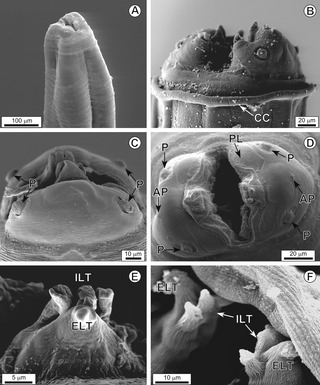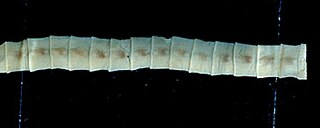
Anisakis is a genus of parasitic nematodes that have life cycles involving fish and marine mammals. They are infective to humans and cause anisakiasis. People who produce immunoglobulin E in response to this parasite may subsequently have an allergic reaction, including anaphylaxis, after eating fish infected with Anisakis species.

Helminthology is the study of parasitic worms (helminths). The field studies the taxonomy of helminths and their effects on their hosts.

Tube-dwelling anemones or ceriantharians look very similar to sea anemones but belong to an entirely different class of anthozoans. They are solitary, living buried in soft sediments. Tube anemones live inside and can withdraw into tubes, which are composed of a fibrous material made from secreted mucus and threads of nematocyst-like organelles known as ptychocysts. Within the tubes of these ceriantharians, more than one polyp is present, which is an exceptional trait because species that create tube systems usually contain only one polyp per tube. Ceriantharians were formerly classified in the taxon Ceriantipatharia along with the black corals but have since been moved to their own class, Ceriantharia.

Acanthocephalus is a genus of parasitic worms. One of the species in this genus is Acanthocephalus anguillae, a fish parasite. Acanthocephalans are also found in humans and primates, causing a common zoonotic infection called "human acanthocephaliasis". While pathogens can be transferred among animals and humans, the main source of human acanthocephaliasis is the diet of infected raw fish and insects. Because they are lacking circulatory, respiratory, and digestive systems, Acanthocephalus are exceptionally well-adapted to a symbiotrophic existence.

The thorny-headed worm family Polymorphidae contains endoparasites which as adults feed mainly in fish and aquatic birds. When this taxon was erected by Meyer in 1931, a subfamily Polymorphinae was established in it. As the Polymorphidae as presently understood would then be monotypic, with no basal genera outside the Polymorphinae, the proposed subfamily is redundant for the time being and therefore most modern treatments simply omit it. Polymorphus minutus is an economically significant parasite in goose and duck farming.

Diomedeoides is a prehistoric genus of seabirds. The family was in the order Procellariiformes which today is composed of the albatrosses and petrels. At present it is the only genus in the family Diomedeoididae. There are three described species. The taxonomy of the family and genus is still in need to revision, and it is likely that the genus name Diomedeoides is actually the junior synonym to Rupelornis.

Echinorhynchus is a genus of acanthocephalan parasitic worms. They parasitize a wide variety of fishes from both marine and fresh waters. The intermediate host is usually a crustacean.

Cetotheriopsis is a genus of extinct cetaceans of the family Cetotheriopsidae.
Stenurus is a genus of nematode that infects the respiratory system and sinuses of cetaceans, which includes whales, dolphins, and porpoises. Up to 1700 worms may be found in a single host.
Nanophoca is an extinct genus of earless seals from the middle Miocene of Belgium.

Physalopteridae is a family of spirurian nematodes, which belongs to the superfamily Physalopteroidea. Like all nematodes, they have neither a circulatory nor a respiratory system.
Neodiplostomum is a genus of flatworms belonging to the family Diplostomidae.

Bothriocephalus is a genus of flatworms belonging to the family Bothriocephalidae.
Acuaria is a genus of nematodes belonging to the family Acuariidae.
Rodentolepis is a genus of tapeworms belonging to the family Hymenolepididae.
Ascarops is a genus of nematodes belonging to the family Spirocercidae.

Mermis is a genus of nematodes belonging to the family Mermithidae.
Tetrabothrius is a genus of flatworms belonging to the family Tetrabothriidae.
Baruscapillaria is a genus of nematodes belonging to the family Capillariidae.










